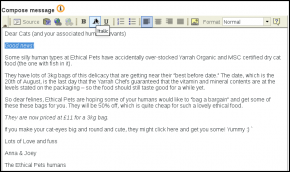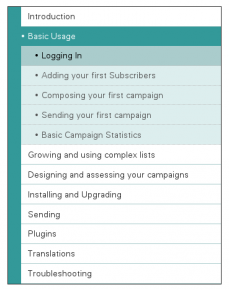phpList has a new manual: a thorough, goal oriented and user friendly guide to using phpList. The manual makes few assumptions about the readers current technical prowess: everything from logging in and starting a campaign to list segmentation and bounce processing are covered in detail. The manual was written by the phpList community and is suitable for large teams and lone-users. It is published on a CC-BY-SA licence: remixing is encouraged. Help us launch the manual in style.
Goal and Task Oriented
The manual uses common email campaign and marketing goals to structure the information, rather than simply being a feature-by-feature description of phpList functionality. For example the goal of Growing and using complex lists frames chapters describing importing subscribers, using placeholders and segmentation. Designing and assessing your campaigns helps the reader learn, for example, how templating works and how to drilldown into clicks and opens to the subscriber level.
The majority of chapters follow a specific task from start-to-finish, along (what we suggest is) the best-practice workflow in phpList. Each step is accompanied by a screenshot. If there are several possible workflow’s, likely use-cases of each are also descried: for example, in the Adding Subscribers (to Lists) chapter, there are three possible workflows.
Chapters are carefully structured to allow all users to follow the same documentation: this will allow users to build up their skills over time as their lists grow.
Focus on phpList usage makes manual suitable for larger teams
The manual uses a “day-to-day-things-first”, rather than a “first-things-first” approach. The first chapters assume that “someone” has already installed phpList, imported some subscribers and configured it for sending: this many have been an in-house IT department, a paid professional or perhaps the user has a phpList.com account. The user may even be taking over from a previous employee, and needs to learn how to send emails from an already well-used system.
This allows the initial chapters on basic use to provide a pedal-to-the-metal approach to writing and sending a campaign. This makes the manual suitable for larger teams or professional environments. Additional phpList.com and phpList.org can pool resources and share one documentation source. Finally, this makes the whole experience more user-friendly:for the majority of readers, who spend most of their time “using” and not installing the app.
The manual still provides everything that a “lone user” needs to get started: installation, sending configuration and bounce processing. These chapters are towards the end of the manual, as they are considered more advanced.
Real-world examples
In addition to the hands-on, goal driven style, the majority of examples are used are genuine campaigns sent by real phpList users (rather than theoretical examples). We wish to add more variety to the nature of the examples over time, and would encourage projects to donate screenshots of their phpList to accompany chapters.
Aimed at Jane
The manual is aimed at the Jane and Joe bloggs phpList user: very little technical or marketing knowledge is presumed. Many chapters include information that will promote learning about email marketing in general, as well as using phpList technically. This was an important goal for many in the documentation team. As an Open Source project, phpList offers freedom for technology users: improved “IT literacy” allows these freedoms to be used in practice.
We want phpList users to be empowered in reality, not just in theory.
Mix and Mash
The manual is published in Open Standards formats (notably .odf) under a Creative Commons licence, the Attribution-ShareAlike 4.0 International licence, which allows users to share and remix the manual. One substantial advantage is that larger organisations, such as government departments and large charities, can create/commission custom documentation as a derivative work: they can use examples relevant to their specific situation, even examples from their own installation.
For example an environmental charity with an IT department to manage most technical aspects may wish to create a manual for their campaigns team covers only what is needed to train their campaigns team, and to use examples from a real campaigns they have sent in the past.
Conversely, these projects can also contribute these examples back to the main manual, to broaden the range of real-world examples available to the phpList community.
Collaboratively written
The manual was contributed to by 26 phpList community members. Contributors included phpList.com staff, employees of a few companies/projects using phpList, and individual users on a voluntary basis: this was the very first project of our fledgling documentation team and we are immensely proud of the outcome. We also received support from the FlossManials community.
The Discourse continues
The manual will continue to grow and evolve, as will, we hope, the phpList documentation team. The quickest way to feedback is to post a comment in the corresponding discourse thread, linked at the bottom of each chapter page. Further ways to get involved are explained on the documentation team home page.


